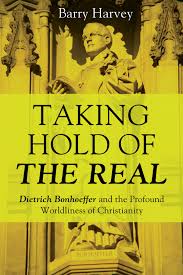Taking Hold of the Real: Dietrich Bonhoeffer and the Profound Worldiness of Christianity
By Diane Reynolds
At the end of Barry Harvey’s Taking Hold of the Real, Harvey contrasts the Confessing Church in Nazi Germany to Andre Trocme’s church at Le Chambon-sur-Lignon, which offered shelter to thousands of Jews fleeing Nazi persecution. In doing so, Harvey illustrates one of Bonhoeffer’s most cherished beliefs: that God and the church live at the center of the village, not on the margins of society in “weakness, death, and guilt.” Neither does God live solely in a sanctified sanctuary space, and certainly not wholly in the afterlife. The difference between Le Chambon and Nazi Germany, Harvey asserts, was that in Le Chambon a group of people had been formed over time to respond compassionately to the persecuted. In contrast, the Confessing Church did not make an adequate response to the suffering, despite Bonhoeffer’s fervent desire to do exactly the kind of formation that led to Le Chambon.
Harvey’s rich and valuable book brings Bonhoeffer’s theology, ahead of its time then and now, into our times, placing it into the context of post-war thinking that tries to understand the church’s mistaken complicity with and amplification of racism, colonialism and other forms of hegemony. As Harvey puts it, his book is “an attempt to think faithfully and truthfully about this time after Christendom, with him [Bonhoeffer] as a primary interlocutor.”
Harvey follows main strands of Bonhoeffer’s theology, placing them in a context dear to Bonhoeffer of reframing how the church must understand its relationship to society if it is to fulfill its mission. The book is so rich it will be impossible to recreate all of its arguments here, but I will touch on some of the highlights.
One of the book’s focuses is Bonhoeffer’s idea of a post-Christendom “world come of age,” reading that phrase as an ironic commentary on an adolescent world’s belief in the “sophistication” of its own technological and ideological achievements, “achievements” Bonhoeffer understood as destructive illusions.
But these illusions, as Bonhoeffer understood, have power—in 1933’s Creation and Fall, he writes that “Humankind is a prisoner, a slave of the world, and its dominion is an illusion. Technology is the power with which the earth seizes hold of humankind and masters it.” Bonhoeffer also notes that separating ourselves from social entanglements does not liberate us, but rather makes us more dependent on the technological regime.
Space for church in modern technological society is vitally important: society attempts “to confine and manage the potentially disruptive practices of the church.” Only by “claiming its own space and organization of that space is the church able to bear witness to a world come of age …”
Harvey discusses religionless Christianity as a faith experience that transcends the culturally bound strictures of institutionalized religion that has been all too complicit since the 1400s with nationalism, modern divisions of the world into controllable segments of space and time that function to harm people, and the segmenting of the world into more and less “civilized” and racialized groups of people, done so that groups can be divorced from their centers and more easily controlled by a world whose power is illusionary. Harvey quotes Bonhoeffer’s contention that, in contrast, “the church is nothing but that piece of humanity where Christ has really taken form.” According to Bonhoeffer, as paraphrased by Harvey, after Christ, “something is substantively different about the world. There is a “different performance of worldliness which requires a break, beginning with baptism.” In the incarnation, “history becomes serious [a term Bonhoeffer often uses to mean real, where actions are important], without being sanctified.” In fact, God’s in-breaking into the world through Christ “makes a difference ontologically. The world no longer is what is was.”
Harvey most interestingly extends Bonhoeffer’s notion of polyphony from the realm of the personal and applies it to the church as a whole. He finds the musical metaphor of polyphony potent, because it is not limiting in the way spatial/visual metaphors can be. He contrasts the potentially infinite possibilities inherent in adding layer upon layer of musical counterpoints to the grounding line of God to spatial or pictorial representations of the world that posit a “zero sum game,” in which one group can only advance by taking another group’s “space.”
Harvey and Bonhoeffer both believe that we need to understand the church’s—or people of faith’s—orientation to the world with a frame that differs from that of the modern or post-modern industrial state. The state would marginalize and neuter faith to make it as little threatening as possible; in push back, people of faith must insist on the kind of spiritual formation that enables them to make the kind of God- and Christ-centered decision for action that are not dependent on what a “world come of age” has decided they should do. After all it is “not a religious act that makes someone Christian, but sharing in God’s suffering in the worldly life.”
I strongly recommend this book. The problems of church that Bonhoeffer faced are strikingly similar to those we face, and our thinking has not yet caught up. Bethge, for instance, made a poignant comment about how heartbreaking it was that after the war, the Protestant church in Germany wanted to go back to January 29 1933. Rather than reflect on what went wrong and how the church needed the change, the people in power wanted to pretend, implied Bethge, that the 12 years of National Socialism never occurred. The church also will continue to flounder and fail to the extent it tries—as it has kept trying in recent decades—to reinvent itself in a way amenable to the worldly power, from “CEO models” to “prosperity” models that replicate the world’s false notion of shalom—until it can, as Bonhoeffer argues, ground itself in a reality apart from structure’s of earthly dominion, in Christ’s reality. Perhaps the hardest part about that is the real thought it requires, when thought, time and contemplation are all at odds with an anti-intellectual, high speed, action oriented society—but this is the thought that Harvey’s book richly engages and that we desperately need to pursue.
Diane Reynolds’ The Doubled Life of Dietrich Bonhoeffer is available through Amazon and Wipf and Stock.

